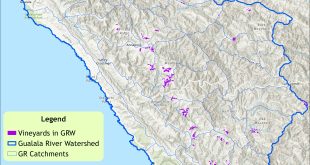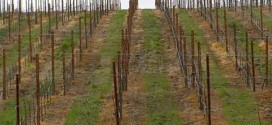Erasing redwoods forests and
Native American history?
by Peter R. Schmidt, PhD
As an early morning mist filters through the Redwoods in the village of Annapolis in NW Sonoma County, a Pomo elder of the Kashia band walks through the forest toward an ancient settlement site. The elder’s presence at this place is linked to a deep concern over ancestors whose memory is endangered by development of this land into vineyard.
While Redwood forest conversion to vineyards is not new to Sonoma County, this particular development entails the conversion of 130 acres of Redwood and mixed timberland into vineyard. Forest conversion not only contradicts the Sonoma County General Plan, but it also threatens key heritage sites that are critical to the cultural well-being of Native peoples.
Concerned about the weak state and county support for preservation of significant ancient and historical places, this Pomo elder’s focus is on the cultural importance that ancient settlements have for the Pomo people. In this case, the concern is well placed.
The zone in which the forest conversion is proposed by Artesa Winery (owned by the Spanish winery Codorniu, one of the largest corporate wineries in the world) was once densely populated by Pomo ancestors. We know this from early anthropological studies done by Barrett and Kroeber, both famous UC Berkeley anthropologists who studied the Pomo and other northern California Native Americans.
The area around Annapolis was an ideal location for settlements between the rich marine resources of the Pacific Ocean and communities located in the interior, especially along the Russian River. The more inland, higher location where Annapolis sits today meant more sun and less fog during much of the year, avoiding the cold and wet along the coastal terrace.
Located just a short distance away from the Gualala River, once a seasonal source of salmon, Annapolis once hosted a wide array of Native American activities in prehistoric and historic settlements, along with other areas where stone tools were manufactured, where shell fish were processed, and where ritual life was conducted. As a zone where development has been limited and population is sparse, Annapolis provides an unusual opportunity to understand and preserve an important part of Pomo history in Sonoma County.
Pomo history has been mostly erased in the interior of the county, along streams and rivers such as Santa Rosa Creek and the Russian River. It is ironic that most of the recent destruction of these Native American settlements and other sites has occurred as a consequence of vineyard development that necessitates the ripping of soils with bulldozers equipped with vertical forks that penetrate deeply to destroy ancient sites, permanently removing any knowledge of the past.
The first Artesa application to CalFire (California Department of Forestry) for the Annapolis property in 2000 elicited a warning from the NW Information Center at Sonoma State University to an archaeological contractor about the area in and around Annapolis having a high probability for Native American cultural resources. Curiously, this early warning has been overlooked in the subsequent 10 years of controversy surrounding the development.
Initial archaeological survey in 2000 located several sites and locales of interest, several of which were later reassessed, demarcated, and required to be protected. Later professional objections about flawed archaeological survey methods however led CalFire to require another survey in 2009. The results from this survey significantly increased the number of known sites, a clear recognition that earlier studies of the property had been inadequate. Yet, this recent survey is also far from adequate, suggesting that a more scientific approach would yield even more site locations.
Additional information gathered by this author shows more locales (and possible sites) within and bordering the project area, suggesting that only the most rigorous survey possible of this property — located in the midst of a highly sensitive historical area — is an acceptable solution for protection of Pomo history. Anything less creates serious questions about how we treat the histories of Native peoples.
The 1989 Sonoma County General Plan (Goal OS-9)* requires review of such projects to “Preserve significant archaeological and historical sites, which represent the ethnic, cultural, and economic groups that have lived and worked in Sonoma County.” [*The Artesa application is subject to the 1989 General Plan as the application was filed before the adoption of the 2009 Sonoma County General Plan.]
When the next Environmental Impact Report for this property is published, Sonoma County authorities must step up and declare their determination to protect this sensitive historical and archaeological zone. Sonoma County planners have pointedly commented on the Draft EIR issued by CalFire in 2009, noting that it is not compatible with many of the 1989 County General Plan goals.
In a letter to CalFire in 2009, Sonoma County Director of Planning Pete Parkinson states that “agricultural activities on forest resource lands is [sic] not compatible with the County General Plan,” a position that arises from an earlier letter to the first application in 2001. Missing from these assessments however is any mention of how historical and archaeological sites linked to Pomo life will be adequately identified and preserved.
Once known as the Gateway to the Redwood Empire, Sonoma County appears to be on the verge of forsaking its natural heritage and its cultural heritage simultaneously. All of those who are concerned about the future of Sonoma County need to ask how we are allowing the destruction of Redwood forests and Native American heritage to emerge as ‘business as usual.’
As the Pomo ask that their sacred places not be disturbed and desecrated, are we not left wondering why we are not stopping this desecration while we have the chance? Hopefully the image of the Pomo elder will remain a promising reminder of a history preserved rather than an image that comes to haunt us.
 Peter R. Schmidt is a graduate of Santa Rosa High School and Stanford University. While at Santa Rosa High in 1960, he assisted the then leader of the Pomo, Essie Parrish, to repair the Round House at Kashia Rancheria east of Stewarts Point. He is currently Professor of Anthropology and Archaeology at the University of Florida and has had a long interest in Pomo history. He is the author of eight books and many scientific articles on archaeological and cultural topics.
Peter R. Schmidt is a graduate of Santa Rosa High School and Stanford University. While at Santa Rosa High in 1960, he assisted the then leader of the Pomo, Essie Parrish, to repair the Round House at Kashia Rancheria east of Stewarts Point. He is currently Professor of Anthropology and Archaeology at the University of Florida and has had a long interest in Pomo history. He is the author of eight books and many scientific articles on archaeological and cultural topics.
Versions of this article appeared in the August 20, 2010 edition of the Independent Coast Observer, and the September 1, 2010 edition of the Santa Rosa Press Democrat as GUEST OPINION: Don’t choose vineyards over redwoods, history.
For additional information, see:
 Pomo heritage threatened
Pomo heritage threatened
The Artesa vineyard project area is “very possibly the Kashaya Pomo village Kabatui” where “human remains may be present,” and which contains rich archaeological areas that are eligible for listing in the National Registry of Historic Places.
 Pomo elders speak out about vineyards
Pomo elders speak out about vineyards
Where we used to live, no one can see anything now. It is time we open our mouths. Those vineyard people are interfering with our ancestors’ area…
 Desecration of Pomo history
Desecration of Pomo history
A first step toward satisfying the responsibility for Europeans and their descendants in North America would be to treat indigenous people with respect.
Artesa (“Fairfax”) vineyard conversion EIR
 CAL FIRE released the Final Environmental Impact Report (EIR) for Artesa Winery’s plan to clear-cut 154 acres of coastal redwood forest to plant a vineyard in Annapolis. The EIR states that the project will have no significant environmental or cultural impacts.
CAL FIRE released the Final Environmental Impact Report (EIR) for Artesa Winery’s plan to clear-cut 154 acres of coastal redwood forest to plant a vineyard in Annapolis. The EIR states that the project will have no significant environmental or cultural impacts.
 Friends of Gualala River Protecting the Gualala River watershed and the species living within it
Friends of Gualala River Protecting the Gualala River watershed and the species living within it


